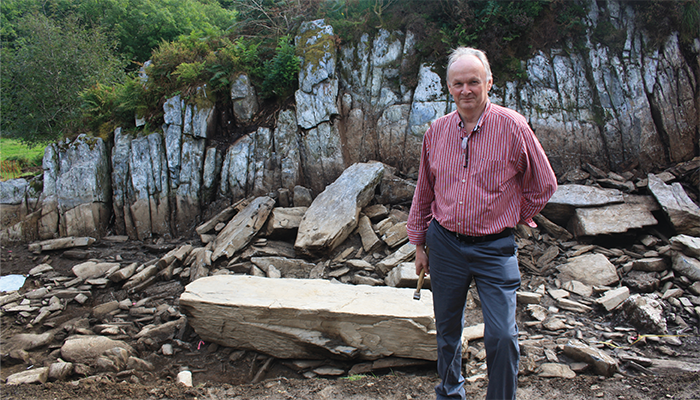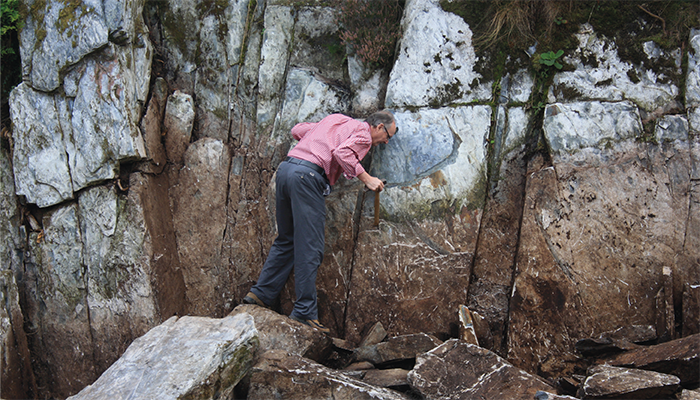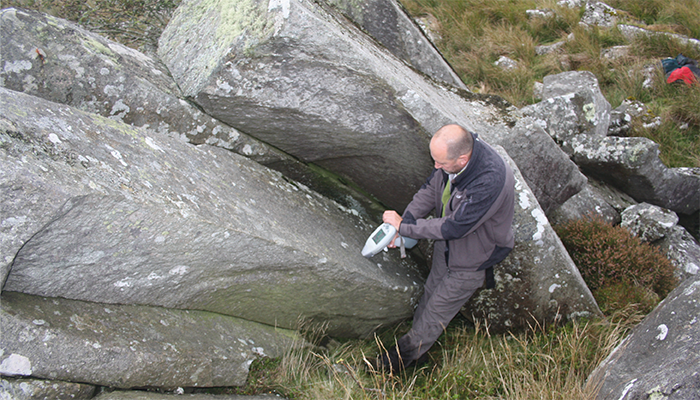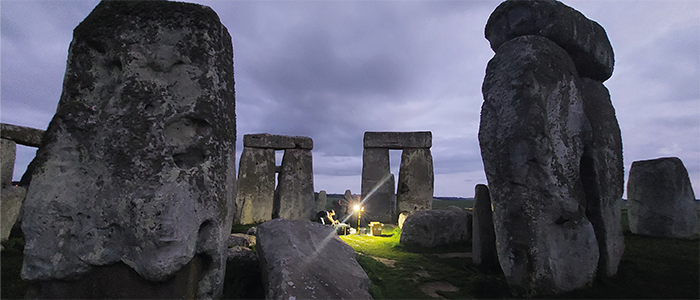A quick internet search about Stonehenge raises more questions than answers about the origin and history of the Neolithic monument. (We are fairly certain that it was not built by aliens.)
With the power of spectroscopy, researchers from Italy, Canada, and the UK collaborated to analyze the mineralogy of the Stonehenge Altar Stone, revealing that its origin is not the same as the rest of the “bluestones” – a detail that could unveil more about the migration of the British Neolithic ancestors, their cultural and religious practices, and thus Stonehenge’s history (1).

Richard Bevins at Craig Rhos-y-Felin in the Mynydd Preseli area, a site identified as the source of rhyolitic debris at Stonehenge. Photo by Christine Faulkner.
Richard Bevins, Honorary Professor at the Department of Geography and Earth Sciences, Aberystwyth University; Nick Pearce, Professor of Public Policy and Director of the Institute for Policy Research (IPR) at the University of Bath; and Sergio Andò, Associate Professor, Department of Earth and Environmental Sciences, University of Milano Bicocca discuss how spectroscopic analysis enabled them to make this significant discovery and discusses the future of miniaturized spectroscopy in geochemical research.
What makes the Stonehenge Altar Stone so special?
The majority of the Stonehenge bluestones (originally known as “Foreign Stones”) were sourced to the Mynydd Preseli area in southwest Wales by H.H. Thomas in 1923. Monoliths, like the bluestones used in the construction of stone circles, are usually locally derived. This is not the case for Stonehenge; in fact, its bluestones represent one of the longest transport distances known from source to monument construction site anywhere in the world.
Using modern analytical techniques, we have been able to refine the provenance of the majority of the bluestones – some down to particular outcrops of igneous rocks which have been identified as Neolithic quarry sites following excavations by our archaeological co-workers. But one bluestone (Stone 80, known as the Altar Stone), is anomalous; it is not of igneous origin but is a gray-green sandstone and is clearly unrelated to the other bluestones. Thomas considered that it also came from southwest Wales, deriving from outcrops of Old Red Sandstone age in that region. Identifying the source of the Altar Source could have important implications for understanding the migration of people in Neolithic Britain and the significance of their stone monuments.

Richard Bevins at Craig Rhos-y-Felin in the Mynydd Preseli area, a site identified as the source of rhyolitic debris at Stonehenge. Photo by Christine Faulkner.
Why did you choose spectroscopy for your analysis?
Different approaches can be used to characterize the mineralogy of a sedimentary rock – but most conventional techniques do not allow the recognition of minor minerals or other essential characteristics of the rock. Another constraint to bear in mind is that archaeological material analysis – almost always – needs to be non-destructive and often only very small quantities are available for study. These factors mean that some standard analytical techniques cannot be applied.
In recent decades, spectroscopy has established itself as an excellent technique for the non-destructive analysis of such sensitive material in the cultural heritage domain. Because of the sensitive nature of the Stonehenge monument, we have applied largely non-destructive techniques to our in situ and laboratory-based investigations; X-ray fluorescence (both desktop and portable instrumentation), X-ray diffraction and automated scanning electron microscopy combined with energy-dispersive X-ray spectroscopy, combined with standard transmitted and reflected light microscopy.
Using a portable XRF, we have identified the geochemical signature for the Altar Stone. Raman spectroscopy (conducted at the Università of Milano, Bicocca) was especially useful in identifying minerals – baryte, apatite, zircon and, garnet – because we applied a single grain approach, directly directing the laser at grains embedded in the bonding resin, we could couple the morphological features of each single grain along with a formal species identification.
Some minerals when examined using standard transmitted light microscopy are not transparent to light and are difficult to identify. When Raman spectroscopy is combined with reflected light microscopy, however, it is possible to identify the varieties of iron oxides/hydroxides and titanium oxides present and to separate one sandstone from another. This approach was fundamental in our study and enabled us to distinguish between samples of the Old Red Sandstone sequences in Wales. Such a high-resolution approach is required to fingerprint the possible source of rocks used in archaeological monuments.

Professor Nick Pearce using a portable XRF to analyse spotted dolerite at Carn Goedog in the Mynydd Preseli, one of the sites idenfied as a source for spotted dolerite bluestones at Stonehenge. Photo by Richard Bevins.
What was the biggest challenge during your study?
The major challenge working on these types of materials is the non-destructive analytical approach that is required because it constrains data collection. A fresh rock surface is chemically different from a weathered surface, as is a wet or dry surface because of X-ray attenuation by water. So, we developed specialized protocols to get “bulk surface” (many analyses across samples) data, ensuring that we obtained data from similar surfaces by portable XRF and maintained day-to-day instrument stability/reproducibility. Despite employing field-based equipment, there are always issues related to the weather conditions, such as those encountered when working outdoors in the UK – which affected our analysis at times. In situ analysis at Stonehenge and at the possible source sites has been extensive and time-consuming, but always detailed and non-invasive nonetheless. However, as “destructive” sampling and analysis has been allowed in the past, comparison of our study with these earlier bulk analyses can be performed, but the different approaches can make this rather challenging.
What were your key findings?
The key accessory minerals identified during this study of an Altar Stone fragment were baryte, apatite, zircon, garnet, coupled with an absence of oxides and hydroxides of iron. The varieties of garnets and Ti-oxides and the crystallinity of zircon was established by Raman spectroscopy as a reference for future comparison with the same minerals in other samples. We also recorded that, in the Altar Stone, the apatites are all rounded – baryte is often corroded or angular, while the phyllosilicates, such as chlorite and biotite, which are larger in size than the other minerals, have very rounded rims. These are all distinctive characteristics of the Altar Stone, which are not found in samples which have a similar mineral makeup from potential source rocks elsewhere.
Our investigations have led us to the conclusion that the Altar Stone did not come from southwest Wales and in fact does not come from the geological region known as the Anglo-Welsh Basin. This was an unexpected result and means that we now need to broaden our stratigraphic and geological horizons; we must look at rock sequences from different parts of Britain, in particular northern England and Scotland where similar rock types occur. Identification of a source in one of these two regions would have important implications for understanding communications between Neolithic populations in Britain, as well as their trading and migration.

Undertaking night time Raman Spectroscopy analysis of the Altar Stone onsite at Stonehenge. Photo by Sergio Andò
How would further miniaturization or other technological advances help in future geochemical studies?
Miniaturization would make portable XRFs lighter – carrying one all day with a few spare batteries in rugged terrain is physically demanding! I’m sure we can also expect better performance – better detectors with better signal/noise characteristics perhaps, more intense X-ray generators to provide better signals. Nonetheless, there are physical issues that cannot readily be overcome so easily, such as the attenuation of light X-rays in air, so some aspects of methods like pXRF will always have some physical limits upon them.
For studies like the Altar Stone work, we still need to study bulk surface analysis of coarse-grained rocks, so making things that can analyze smaller areas on the surface of a sample (akin to the move to microanalysis in geochemistry, for example) would be of no benefit. The recent innovation of transportable Raman spectroscopes has made it possible to take the instrumentation to field locations. Further miniaturization could give portable Raman devices the same level of data acquisition (e.g. the same resolution) as current, heavier laboratory-based instruments – and that would enable more comprehensive analysis of many rocks in other situations, where invasive sampling is prohibited.
What is next for you and your research?
Our research is still on-going and the next phase of work will involve fieldwork in northern England and Scotland to see if we can identify gray–green sandstone with the same overall mineralogy and geochemistry as the Altar Stone. We’ve already conducted desktop reviews of geologically-relevant areas to establish a sample collecting strategy, and fieldwork is planned for March–April 2024. After that, we’ll conduct further analytical investigations; again the combination of portable XRF and Raman spectroscopy techniques will help verify the presence or absence of diagnostic minerals (baryte, carbonates, K-feldspars in the case of the Altar Stone) – providing a mineralogical fingerprint without the need for extracting chips of stone from archaeological monuments.
References
- RE Bevins et al, Journal of Archaeological Science: Reports, 51 (2023). DOI: doi.org/10.1016/j.jasrep.2023.104215




